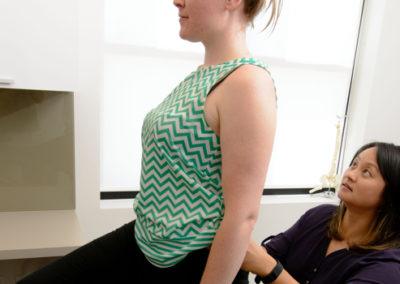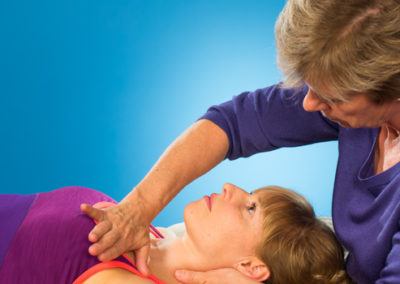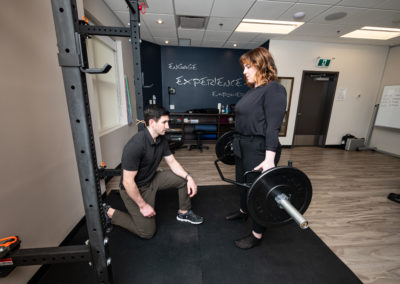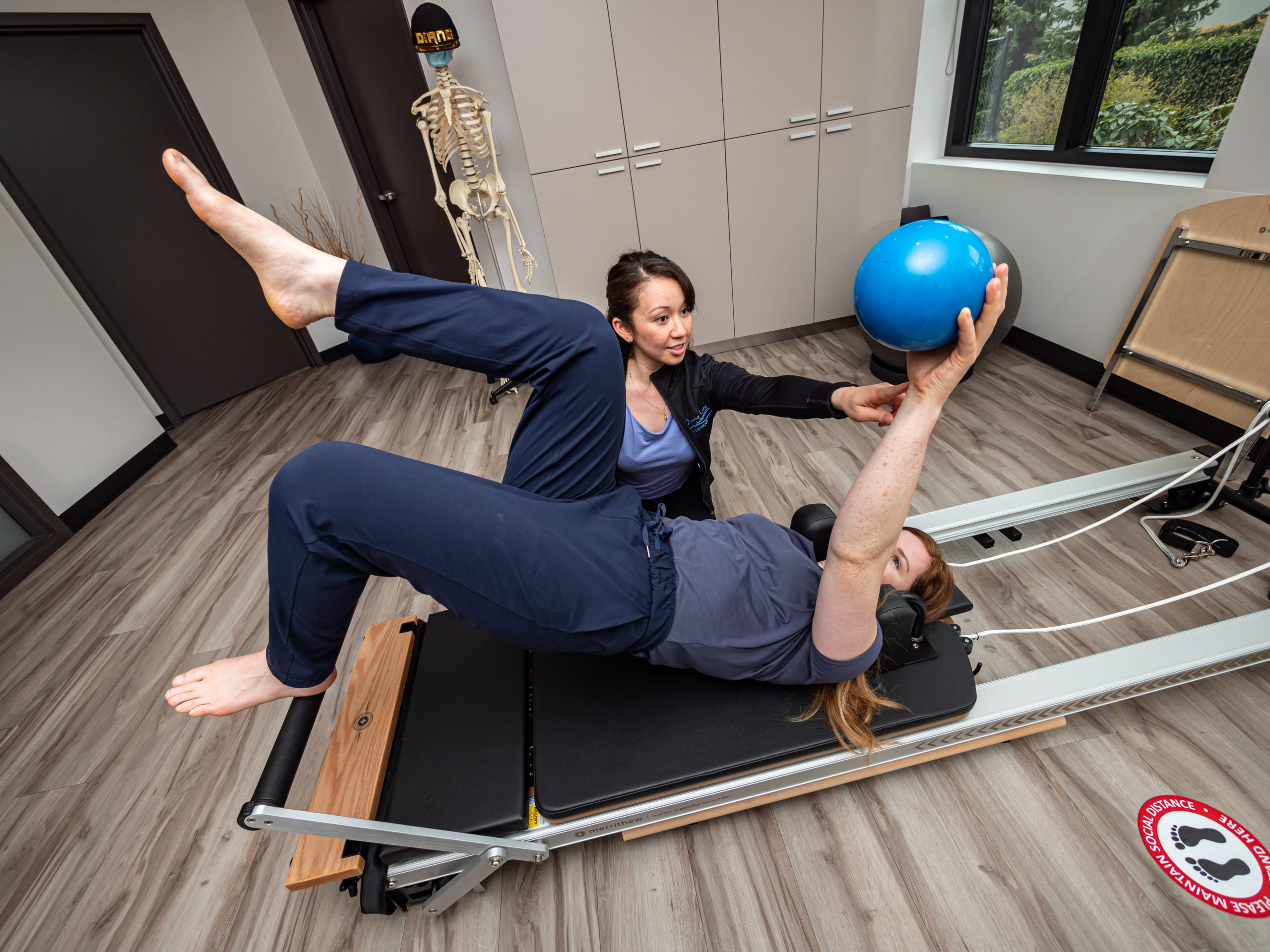We all manage gravity and load in different ways and in health we have a number of different ways to choose from. In science, the ‘ways’ are called strategies. The strategy we use for the task at hand is often based on our body’s structure, the size of the load we are about to handle, the movement we are about to make, how predictable the situation is and what our habits have been. Three common non-optimal strategies for managing loads through the trunk (chest, low back, pelvis and hips) are called:
- Butt-gripping
- Back-gripping and
- Chest-gripping
Each non-optimal strategy can lead to a wide variety of symptoms, including, but not limited to, low back pain, pelvic pain, mid-back pain, groin pain etc. How do you know if you are a butt, back or chest-gripper? Perhaps your physiotherapist has told you. If not, consider the following.
Are You a Butt-Gripper?
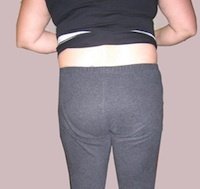
Take a photo of your buttocks in either your underwear, or some tight exercise pants, and compare your buttock to the picture on the right. This picture is of someone butt-gripping on both the left and right sides. Note the puckering of the fabric at the bottom of the pelvis. Sometimes you will even see the fabric go up the cleft of the bum, sure signs that you are using a non-optimal strategy for managing the loads of life and gravity through your pelvis and that you are a butt-gripper.
You can also test yourself by feeling the shape of your buttock. Stand up and place your hands on the sides of your hips just behind the bone at the top of your leg (greater trochanter). Do you feel a big divot under your hand? Can you relax your buttock muscles, or do a small squat, and does this change the shape/divot any further? Once you become aware of this clenching or gripping habit you will begin to notice how often during the day you use this strategy.
You are not alone. Butt gripping is a common strategy seen in men with athletic histories (hockey players, soccer players) dancers who walk with their feet pointing outwards, and is also commonly seen in mothers.
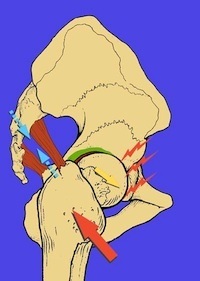
The consequences of butt-gripping are that this strategy:
- forces the head of your femur forward in the hip socket and stresses the tissues at the front of the hip crease potentially leading to groin pain or pain around the pubic symphysis
- restricts the movements of your hip joints, particularly for movements that involve hinging at the hips (bending forward, squatting, sitting) and thus impacts how you bend forward and how you squat (move in and out of a chair). The figure on the left below is of an optimal squat. The breast bone is lined up over the pubic bone, the hips, knees and ankle fold such that the line of gravity is directly through the center of the knees and feet and the spine is maintained in a neutral position. On the right, is a picture of the same individual squatting with her usual strategy – she is a butt-gripper. Note how her bum is tucked under, the distance from her breastbone and pubic bone is shortened, her neck is extended and her low back is rounded (flexed). Her butt is way behind her feet and she lifts her arms to counterbalance her weight. This is not a great position for power or for mobility, yet this is often how people move to sit into a chair.

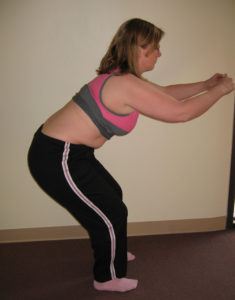
Watch this short video clip of a butt-gripping strategy and the postural and movement corrections necessary to perform an optimal squat.
Sit Training for the Butt Gripper
People who grip just one side of their buttock, or hip, when they squat will often sit with their pelvis twisted and rotated. The twisted pelvis sets up a twisted spine and blocks the ability to freely rotate your chest while sitting.
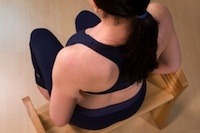
People who grip just one side of their buttock/hip when they squat will often sit with their pelvis twisted. The twisted pelvis sets up a twisted spine and blocks the ability to freely rotate your chest while sitting.
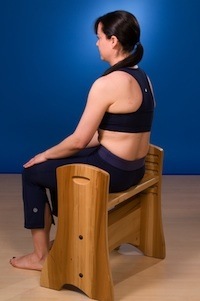
People who grip both sides of their buttock/hip when they squat will often end up sitting on the posterior aspect of their pelvis.
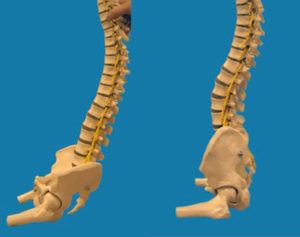
Note the difference in the lumbopelvic alignment between the poor posture for sitting on the left and the optimal posture for sitting on the right.
Watch the following video clip (our heads are cut off to protect the client’s privacy) to see how the butt-gripping strategy is corrected through teaching an optimal squat to sitting and some key points to consider while sitting if you are a butt gripper.
Are you a Back-Gripper?
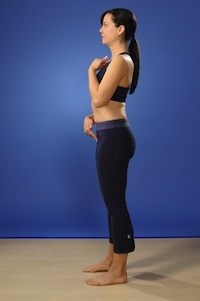
Do you subconsciously lift your chest to correct your posture all day?
Take a photo of your posture from the side and compare to the picture above. This picture is of a bilateral back gripper. Note the forward tilt of her pelvis and the long curve of her spine. There is lots of work being doing by the long back muscles in this posture, which is often associated with multiple trigger points in the back muscles. Back-grippers love massages and stretching into forward bending, however it only gives them temporary relief because as soon as they stand again, they fall back into the back-gripping posture.
Back gripping is a common strategy seen in dancers, gymnasts and others who have tried to ‘sit up tall’, be bigger, stick out their chests etc. It is the military stance. The consequences of sustained back-gripping are that this strategy:
- forces the joints of your spine together and potentially causes a mid or low back ache, especially when you stand for prolonged periods of time,
- limits the ability of your spinal joints to bend forward and lengthens your anterior abdominal muscles which makes them less able to support you.
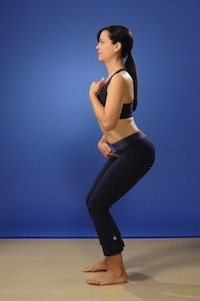
When a back-gripper squats, the back tends to arch more and this further loads the joints of the spine. Again, this is not a great position for transferring loads or for mobility.
Back-grippers need to practice a functional squat and to learn to balance the loads such that their back is not overly loaded. While butt-grippers need to focus on releasing their hip joints (see above), back-grippers need to think about lengthening their spine and maintaining the distance between the breast bone (upper hand in this figure above) and the pubic bone (lower hand on the figure above). If this is you, practice your squats with a broomstick down your back to help you maintain the neutral spine posture as you direct your hips down and back as if to sit in a chair.
Are you a Chest-Gripper?
Do you subconsciously squeeze your chest or upper abdomen in an attempt to flatten your lower abdomen? Does your lower abdomen protrude no matter how hard you try to flatten it and when you press on it does it feel really firm (like a balloon filled with pressure)?
Take a photo of your posture from the side and compare it to the picture on the left below. This picture is of an extreme chest-gripper. In a more subtle chest-gripper you see a narrowing of the chest and two long lines running vertically down the abdomen.
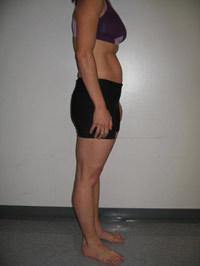
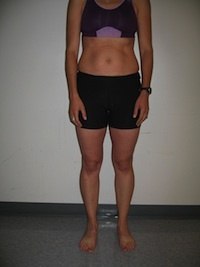
Note the protrusion of her lower abdomen and the apparent intra-abdominal pressure. Using the external oblique muscle (superficial abdominal) too much is a common occurrence in women with stress incontinence (leakage of urine) and hopefully you can see why. Prolonged use of this strategy, and the excessive increase in intra-abdominal pressure it creates, is difficult for the pelvic organs (bladder & uterus) and the pelvic floor muscles to handle for very long.
If you think you are a chest-gripper, put your hands on either side of your chest and take a breath. Chances are, your lower chest doesn’t expand much and most of your breathing happens in either your upper chest or belly.
Chest-gripping is a common strategy seen in a lot of postpartum women attempting to regain a flat tummy as well in athletes who have done a lot of situps and oblique abdominal curl-ups (situps with rotation). The long term consequences are that this strategy:
- compresses the joints of your rib cage thereby restricting rotation and extension of your trunk – this is really bad for your golf or tennis swing
- restricts the ability of your rib cage to expand and can potentially lead to disordered breathing and a whole host of symptoms that go along with that
- significantly increases your intra-abdominal pressure putting your pelvic organs at risk for prolapse and for stress urinary incontinence.
Learning to breathe properly is essential for the chest gripper. In a supine supported position (lying on your back with your knees and hips bent) put your hands on either sides of your rib cage. Think about relaxing the muscles of the upper abdomen and breathe into your hands slowly expanding your lower rib cage like an umbrella – all the way around. Move this practice to sitting and then to standing. DON’T try to flatten your abdominal wall by drawing your navel to spine – this only tightens these superficial abdominals more, relax the chest, relax your upper belly and find your cue for the deep muscle system – see Training for the deep muscles of the core.
Call us today – we’d love to help get you back on track to living with an active, healthy body.
Call us today
We’d love to help get you back on track to living with an active, healthy body.


